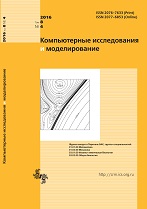|
This article is cited in 5 scientific papers (total in 5 papers)
MODELS IN PHYSICS AND TECHNOLOGY
Modeling thermal feedback effect on thermal processes in electronic systems
A. G. Madera
Scientific Research Institute for System Analysis, RAS,
36/1 Nakhimovsky Prospekt 36, build. 1, Moscow, 117218, Russia
Abstract:
The article is devoted to the effect of thermal feedback, which occurs during the operation of integrated circuits and electronic systems with their use. Thermal feedback is due to the fact that the power consumed by the functioning of the microchip heats it and, due to the significant dependence of its electrical parameters on temperature, interactive interaction arises between its electrical and thermal processes. The effect of thermal feedback leads to a change in both electrical parameters and temperature levels in microcircuits. Positive thermal feedback is an undesirable phenomenon, because it causes the output of the electrical parameters of the microcircuits beyond the permissible values, the reduction in reliability and, in some cases, burn out. Negative thermal feedback is manifested in stabilizing the electrical and thermal regimes at lower temperature levels. Therefore, when designing microcircuits and electronic systems with their application, it is necessary to achieve the implementation of negative feedback. In this paper, we propose a method for modeling of thermal modes in electronic systems, taking into account the effect of thermal feedback. The method is based on introducing into the thermal model of the electronic system new model circuit elements that are nonlinearly dependent on temperature, the number of which is equal to the number of microcircuits in the electronic system. This approach makes it possible to apply matrix-topological equations of thermal processes to the thermal model with new circuit elements introduced into it and incorporate them into existing thermal design software packages. An example of modeling a thermal process in a real electronic system is presented, taking into account the effect of thermal feedback on the example of a microcircuit installed on a printed circuit board. It is shown that in order to adequately model the electrical and thermal processes of microcircuits and electronic systems, it is necessary to take into account the effects of thermal feedback in order to avoid design errors and create competitive electronic systems.
Keywords:
electronic system, microcircuit, thermal feedback, temperature, electrical parameters, thermal model, simulation.
Received: 17.04.2018
Revised: 24.04.2018
Accepted: 10.05.2018
Citation:
A. G. Madera, “Modeling thermal feedback effect on thermal processes in electronic systems”, Computer Research and Modeling, 10:4 (2018), 483–494
Linking options:
https://www.mathnet.ru/eng/crm459 https://www.mathnet.ru/eng/crm/v10/i4/p483
|

| Statistics & downloads: |
| Abstract page: | 224 | | Full-text PDF : | 121 | | References: | 29 |
|




 Contact us:
Contact us: Terms of Use
Terms of Use
 Registration to the website
Registration to the website Logotypes
Logotypes








 Citation in format
Citation in format 
